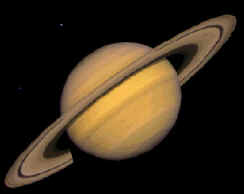BACKGROUND:
|

Saturn, a gas giant
|
The Sun, the planets, and countless minor objects such
as asteroids and comets make up the Solar System. The Solar System is
dynamic, always moving. Almost all of its components revolve around the Sun,
held in orbit by immense gravitation attraction of the Sun. All of the
planets, and many smaller objects also rotate, or spin on an axis.
The planets can be divided into two groups. Mercury,
Venus, Earth and Mars form the terrestrial planets. They are small and are
composed of rock and metal, like the Earth. Jupiter, Saturn, Uranus, and
Neptune are grouped as the Jovian or gas giant planets, because of their
large sizes and gas-rich compositions. There is most likely a solid core in
the gas giants, but this has not been confirmed. Planetary scientists know
too little about Pluto to include it in either group. It is probably a
terrestrial-like planet.
In the last decade, a wealth of new information on
each of the planets has become available. The table on the next page
summarizes several characteristics of each planet. Note that the temperature
given for Venus is a direct measurement from a Russian spaceship for
daytime. For Jupiter, Saturn, Uranus, and Neptune, the temperatures are
averages.
|
PLANET |
diameter (km) |
length of day |
length of year |
lowest surface temp
C°
|
highest surface temp C°
|
|
MERCURY |
4,880 |
59 days |
88 days |
-170 |
+400 |
|
VENUS |
12,100 |
243 days |
224.7 days |
? |
+480 |
|
EARTH |
12,740 |
24 hours |
365.25 days |
-53 |
+50 |
|
MARS |
6,794 |
24.5 hours |
687 days |
-143 |
+17 |
|
JUPITER |
143,200 |
10 hours |
11.86 yrs |
? |
-148 |
|
SATURN |
120,000 |
10.5 hours |
29.46 yrs |
? |
-178 |
|
URANUS |
51,800 |
15.5 hours |
84 yrs |
? |
-214 |
|
NEPTUNE |
49,500 |
18.5 hours |
165 yrs |
? |
-218 |
|
PLUTO |
2,500 |
6.5 days |
248 yrs |
? |
-330? |
PROCEDURE:
- Hand out the Solar System Placemats and worksheets. Have the students
fill out the worksheet using the placemat. Review their answers, using
the chart shown above. Notice that the inner or terrestrial planets:
Mercury, Venus, Earth and Mars are more similar as a group, than the
Jovian or gas giants of Jupiter, Saturn, Uranus, and Neptune. Pluto is
different, but considered a terrestrial-like planet.
- You may want to use this exercise to help students learn how to use
search engines on the Internet. Have them go to your favorite search
engine and use the names of the planets for a search. They can get the
information from the internet instead of the placemats.
- Discuss any new information that students have learned. Remember
the Internet probably has more current information.
|